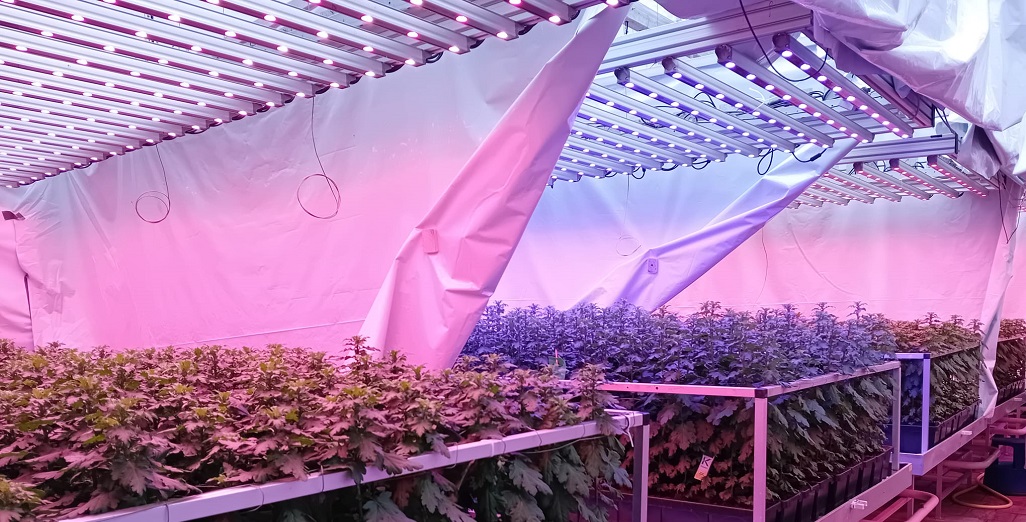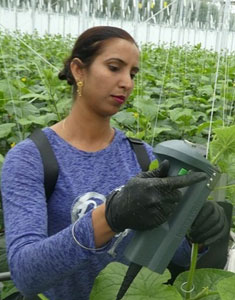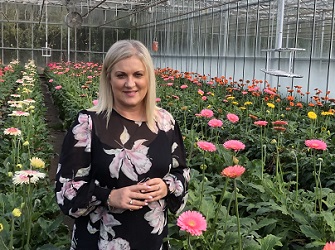Sign up here to subscribe to the Grower2grower Ezine. Every two weeks you will receive new articles, specific to the protected cropping industry, informing you of industry news and events straight to your inbox.

Grow light research confirms effect on energy consumption and crop, as experience has shown with other crops
If white light is not strictly necessary in LED installations for grow lights, it is better to avoid it. Compared to red and blue light, it does not add value to the crop, but energy consumption does go up. That’s the conclusion we have drawn after extensive testing with light recipes using the Philips GreenPower LED production module dynamic. The recent results in basil cultivation confirm previous experience in, among others, lettuce, tomato and spinach crops.
There is a lot of talk about the use of white light in LED installations for grow lights. It is more comfortable to work with white light, and you can assess the color of crops better. When people have to work in the crop on a regular basis, a little white light is therefore quite useful at times when there is no daylight available. In other situations, white light does not add any value for the plant, compared to red and blue light, and it only increases costs.

Trials with basil
In a climate chamber at the Philips GrowWise research center, three basil crops were grown consecutively under different light recipes. The light level was 220 µmol/m2/s in each case, with varying amounts of white light at the expense of red and blue light.
The bar graph below shows how the input of white light does result in higher energy consumption (relative kWh, reference = 100), but does not yield more fresh weight. In fact, the fresh weight decreases as the proportion of white light increases. The quality of the harvested basil remains the same.

Signify’s research confirms previous experiences with other crops, which were also gained elsewhere. Research on young tomato plants at Wageningen University & Research (Dieleman et al., 2022) into the influence of green and white light yielded the same results. Research on lettuce and spinach, as well, has already shown that white light does not yield growth gains; rather, it only increases costs.
Dynamic grow light is the future
So, is there no role at all for white light in LED crop lighting installations? Yes there is, but only when people have to work in the crop and there is no or too little natural daylight available. To be able to work comfortably in a greenhouse, about 5% white light is sufficient.
For daylight-free cultivation, efficient lighting for the plants and people should be achieved with a dynamic LED installation, in which both the brightness and the spectrum can be tailored to the needs at any given time. Only then can you optimize the relationship between crop yield (output) and energy consumption (input) while respecting labor conditions.
Did you know that additional blue light has no impact on the taste and quality of basil either? Read our blog on this effect.

Above – Silvia Booij is a researcher at Signify Research. She has been working on plant-related research for four years with the Horticulture City Farming team. She is a physicist with a background in optical design. Together with Leonie, she is in charge of the experiments in the research cells of the Philips GrowWise Research Center.

Above – Leonie Geerdinck is a researcher at Signify Research. She has been working with the Horticulture City Farming team for three years. She has a background in chemical technology and as a light application specialist. She is researching the influence of light on the growth and quality of crops, as well as the effect of light on human experience and visual perception.
For further information, please contact:
Philips horticulture LED solutions by Signify
Daniela Damoiseaux – global marcom manager
Tel: +316 40578311
E-mail:Daniela.damoiseaux@signify.com
About Signify
Signify (Euronext: LIGHT) is the world leader in lighting for professionals and consumers and lighting for the Internet of Things. Our Philips products, Interact connected lighting systems and data-enabled services, deliver business value and transform life in homes, buildings and public spaces. In 2021, we had sales of EUR 6.9 billion, approximately 37,000 employees and a presence in over 70 countries. We unlock the extraordinary potential of light for brighter lives and a better world. We achieved carbon neutrality in 2020, have been in the Dow Jones Sustainability World Index since our IPO for six consecutive years and were named Industry Leader in 2017, 2018 and 2019. News from Signify is located at the Newsroom, Twitter, LinkedIn and Instagram. Information for investors can be found on the Investor Relations page.
Global Marcom Manager Horticulture at Signify
Daniela Damoiseaux
Tel: +31 6 31 65 29 69
Email: daniela.damoiseaux@signify.com
New Zealand Contact:
Graeme Neale
Business Development Manager
Specification, Systems and LED Agriculture Solutions
Mobile + 64 21 2254526
Email graeme.neale@signify.com
Level 3, 123 Carlton Gore Road,
Newmarket, Auckland 1023

Australian Contact:
Aart Slobbe
Account Manager Horticulture LED Solutions
+ 61 448 881 338
Email aart.slobbe@signify.com
Suite 022, 44 Lakeview Drive
Scoresby, VIC 3179, Australia

About Signify
Signify (Euronext: LIGHT) is the world leader in lighting for professionals and consumers and lighting for the Internet of Things. Our Philips products, Interact connected lighting systems and data-enabled services, deliver business value and transform life in homes, buildings and public spaces. With 2020 sales of EUR 6.5 billion, we have approximately 38,000 employees and are present in over 70 countries. We unlock the extraordinary potential of light with smart lighting solutions that improve quality of life, and by working towards a sustainable future. We became a carbon-neutral company in 2020, since our stock market listing, we have been in the Dow Jones Sustainability World Index for four years in a row and were named Industry Leader in 2017, 2018 and 2019. News from Signify is located at the Newsroom, Twitter, LinkedIn and Instagram. Information for investors can be found on the Investor Relations page.
For all media releases please send to marie@grower2grower.co.nz or upload directly: https://www.grower2grower.co.nz/article-form/
CLASSIFIED
Photo
Gallery
Subscribe to our E-Zine
More
From This Category

Integration of Philips GrowWise control system with climate computer allows Huisman Chrysanten to light more effectively and efficiently

New Philips GreenPower LED toplighting force 2.0

Philips GrowWise Research Center to test and showcase intelligent lighting

Can you grow cut chrysanthemums using only red light?

Signify foresees a bright future for vertical farming, driven by automation and diversification.












































